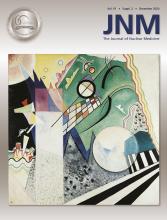More than one hundred years after the discovery of penicillin, infection remains a major threat to humankind. In 2017, more than 8 million deaths and 400,000 years of life lost were due to infection, making it first in morbidity and third in mortality among human diseases (1). Diagnosing infection is challenging, and imaging studies are often used for confirmation, localization, and assessment of its extension. For nearly 50 years, beginning with 67Ga, molecular imaging has played an important role in the diagnosis of infection. Suboptimal imaging characteristics, the typical 48- to 72-h delay between administration and imaging, and the inability of 67Ga to differentiate infection from inflammation, tumor, and trauma inspired the search for better agents (2).
In the mid 1970s, the demonstration by Thakur et al. (3) that autologous leukocytes labeled in vitro with 111In-oxine could image infection in humans was a seminal event. The concept on which this test is based is simple: imaging of a physiologic process, the in vivo migration of radiolabeled leukocytes. Although the concept is simple, the execution is not and depends on several factors, including the imaging characteristics of the radionuclide, the label stability, and the labeled cell viability. Tritium, 32P, and 51Cr, which had been used to label leukocytes, provide data on leukocyte clearance from the blood but are not suitable for studying in vivo kinetics and distribution of leukocytes and cannot be used for localizing infection. 111In has γ-emissions 174 keV and 247 keV, which are suitable for imaging. Its 67-h half-life is sufficiently long to image leukocyte migration and accumulation (3).
The label must be stable, and the labeled cells must be viable Significant radionuclide elution from the cells would confound the interpretation of the test because it would not be possible to differentiate accumulation of labeled leukocytes from accumulation of other radiolabeled complexes or free radionuclide. Once inside the leukocyte, 111In binds to intracellular components with minimal elution; up to 90% of the activity is retained intracellularly at 22 h. Finally, the labeled leukocytes must be viable; leukocyte viability was about 75% (3). To put the work of Thakur et al. (3) into proper perspective, in the decades since its publication, among the several radionuclides (including positron emitters) investigated for labeling leukocytes, only 99mTc has yielded a clinically useful agent (2).
Compared with the ideal molecular infection imaging agent, which should be safe, available, rapidly completed, and sensitive and specific for infection, labeled leukocyte imaging has several weaknesses. The in vitro labeling process requires handling of human blood products, with its associated hazards for personnel and patients. The procedure is labor-intensive and time-consuming and can be performed only by trained individuals. Consequently, in most institutions, the test is available only during routine working hours.
The issue of sensitivity and specificity is not straightforward. Although labeled leukocyte imaging is used for infection imaging, it is in reality host-response imaging, in which the presence of infection is implied by patterns of labeled leukocyte accumulation. In the usual clinical scenario, most leukocytes labeled are neutrophils; the test is therefore most sensitive for detecting those infections in which the primary cellular response is neutrophilic, such as bacterial infections. The procedure is less sensitive for detecting those infections in which the predominant cellular response is not neutrophilic, that is, tuberculosis and some opportunistic infections (2).
Labeled leukocyte imaging is specific for leukocyte-mediated inflammatory processes but is not specific for infection and will be positive in any inflammatory process mediated by neutrophils. For example, the test cannot reliably differentiate septic arthritis from an active inflammatory process such as rheumatoid arthritis (2).
Why then does labeled leukocyte imaging—a procedure that is not without some risk, is not ubiquitously available, and is not specific for infection—still have a preeminent position in molecular imaging of infection? The answer is that, to date, no better agent has come along. Numerous attempts have been made to develop in vivo leukocyte labeling methods using antigranulocyte antibodies, antibody fragments, and peptides, none of which have stood the test of time. Generally they are sensitive, but specificity is variable and they have their own safety issues, including human antimurine antibody development precluding repeat use, and severe adverse events occurring shortly after administration. Attempts to develop infection-specific agents such as radiolabeled antibiotics, vitamins, and antimicrobial peptides have had only modest success, and none have ever made it into routine nuclear medicine practice (2).
The one agent that has gained widespread acceptance for imaging of infection is 18F-FDG. Though not specific, the test is rapidly completed and provides high-resolution images. Furthermore, 18F-FDG is especially useful for those indications for which labeled leukocyte imaging is of limited value, such as tuberculosis, spondylodiscitis, and fever of unknown origin. 18F-FDG, however, is a complement to, not a replacement for, labeled leukocyte imaging (2).
More than 4 decades after its introduction, in vitro labeled leukocyte imaging still occupies a preeminent role in molecular imaging of infection. Considering the rapidity with which modern-day diagnostic imaging tests are developed, this is a remarkable feat.
DISCLOSURE
No potential conflict of interest relevant to this article was reported.
- © 2020 by the Society of Nuclear Medicine and Molecular Imaging.
REFERENCES
- Received for publication May 15, 2020.
- Accepted for publication June 4, 2020.







